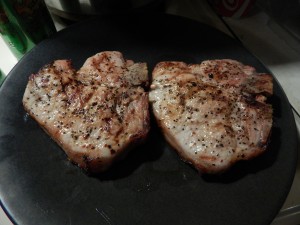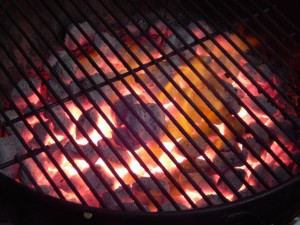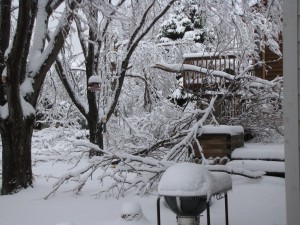Homebrewing and grilling go together like, well, homebrewing and grilling — which is to say quite well. In the dead of winter, however, many backyard chefs let the snow pile up on the grill or smoker, waiting for spring. However, there’s no reason you can’t cook outdoors during the winter. Here’s how.
Watch Your Weather Report
As with any season, weather can change quickly. A seasoned griller will keep an eye on the forecast, looking for days with low winds predicted, and perhaps a few degrees warmer than usual. The former is much more important than the latter. You can grill outside at almost any temperature as long as it is calm. On a windy day, the heat outside the grill is whisked away, leaving a cold interface between the grill cover and the outside air. In calm conditions, a column of heat will rise from the grill and it will lose heat more slowly.
Grill Placement
In addition to looking for calm days, it also pays to find a place for your grill that is protected in case the wind does pick up. However, you must use caution when doing so — grilling inside a garage (or any enclosed space), even with the door open, may lead to carbon monoxide poisoning. Likewise, if you move the grill near a building, look up. Heat from the grill will rise. If there are overhanging icicles or a load of snow on the roof, these can fall onto the grill — or worse yet, you. In many cases, strategically placing lawn furniture or any sort of blockade near the grill can help keep light winds from being a problem.
Dress Warmly
This should go without saying, but dress warmly when grilling outside in winter. I prefer to wear layers of clothes — thermal underwear, undershirt, shirt, “overshirt” and a lighter jacket — than “indoor clothes” and a heavy jacket. In addition, covering your head with a cap is a must. If possible, minimize the number of times you go in or out. If you get sweaty indoors, then go outside, you’ll be colder than if you simply stayed outside.
Add More Fuel
If your grill or smoker burns hardwood or charcoal, add more fuel than usual. The colder it is outside the grill, the more heat you’ll need to compensate for the added heat loss (compared to grilling in summer). If you are grilling a lot of food, have some fuel in reserve. For example, if you use charcoal, light a chimney well ahead of the time you might need more. (Note that propane starts to gel around -44 °F/-42 °C, so don’t try to grill with propane near that temperature. In addition, as a propane tank is used, it cools as the liquid propane turns to gas, so the ambient temperature doesn’t need to be as low as -44 °F/-42 °C. How low you can go depends on how much gas you’ll be using.)
Grill When Fire is at Peak Heat
If you’re using charcoal, your grill temperature will peak right around the time the flames start to die down and the grill will become usable once the charcoal has turned to burning coals. (Put the lid on the grill right before this point and let it heat up for about 5 minutes.) Have the food ready to go and get it on the grill when it’s at its hottest. Ideally, you’ll want a thermometer inside the grill that can be read from indoors. That way you don’t have to keep going outside to check it.
Warm Food Gently Inside Before Grilling
Whatever you’re grilling, you’ve likely stored it in your refrigerator. When you cook it, you’ll need to take it from around 40 °F (4.4 °C) to the safe internal temperature. Given that you know your grill is going to be cooler than usual — and the span of time it remains hot enough to grill foods may be limited — do yourself a favor and warm the food lightly indoors before taking it outside to grill. Rather than letting it sit out for awhile before grilling it, quickly bring it to around room temperature (or slightly above). Put the food in ZipLock bags and squeeze out as much of the air as possible. Then fill a sink with water that just feels warm to the touch, around 100 °F (~40 °C). You don’t want to cook the food, just warm it. Put the plastic bags in the warm water and let them sit for 5–10 minutes. If the food temperature raises to, say, 70 °F (21 °C), you’ve shaved 30 °F (~15 °C) off the temperature gap between the fridge and being finished. In addition, because you’ve done this quickly (as opposed to letting the food sit out on your counter), it’s safer. (You can also use a microwave on low power for this.)
Another way to ensure you have less heating to do is to choose foods that will cook quickly. In very cold weather, selecting slightly smaller amounts of food or thinner cuts of meat will let you grill them quickly and completely, and be inside before the grill starts to cool.
At The Grill
While grilling, you’ll want to conserve heat as much as possible. When putting the food on, don’t overload the grill — space the food a little more widely than you would in the summer. Experience really helps in winter grilling because you want to open the grill as few times as possible. Estimate how long it will take you cook the food and minimize the amount of times you flip it or probe for the internal temperature. (Generally, increased flipping leads to juicier meat — contrary to what is widely believed — but minimize flipping during the winter to conserve heat.) When you do flip the food, try to just crack the lid and flip it all quickly. (This is another reason not to overload the grill). If you’re grilling more than one load of food, keep the uncooked food indoors (for warmth) until just before you need it.
Prepare to Kick Save
If you’re grilling a lot of food, or smoking a large piece of meat, have a backup plan in case the grill cools off too much. Heat the oven to it’s lowest setting, and be ready to turn it up if you think you might need it.
How Cold Was It?

Mmmm . . . pork chops. I grilled these a couple days ago. Of course, I grilled them in Texas and it was 70 °F (21 °C). I did help my dad grill steaks in South Dakota over the holidays, though.
You might not need any of this advice, depending on how cold it is and — more importantly — wind conditions. On a calm day around freezing (32 °F/0 °C), if you’re grilling something that cooks quickly — steaks, pork chops, chicken pieces, kebabs, corn on the cob, etc — all you’ll need to do is throw a couple extra charcoal briquettes on the pile and go about grilling as you normally would. On a colder or windier day, if you’re grilling or smoking a larger piece of meat — or grilling multiple batches of food — the advice above might come into play. Keep an eye on the temperature in the grill or smoker and decide ahead of time at what temperature you’ll pull the food off the grill and finish it inside. Finally, even though it’s cold outside, check on the grill to make sure the fire is out (or all the dampers are closed) once the food is all indoors.



Well, a good piece of information.